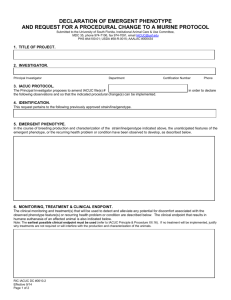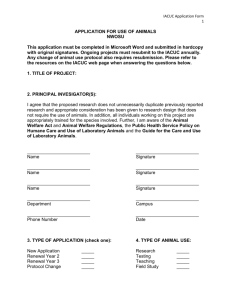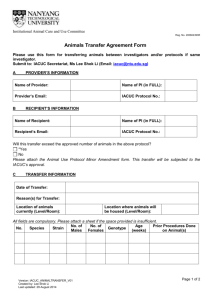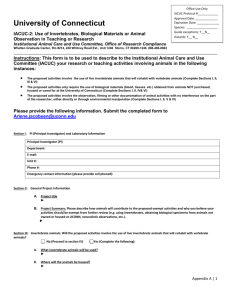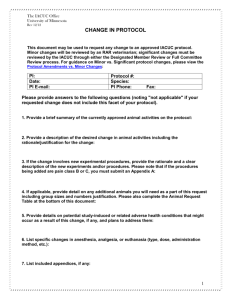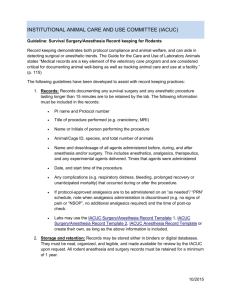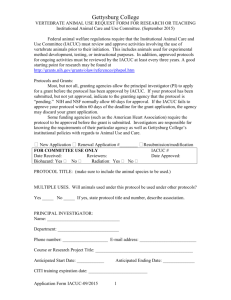Zoo and Wildlife Biomaterials in Research
advertisement
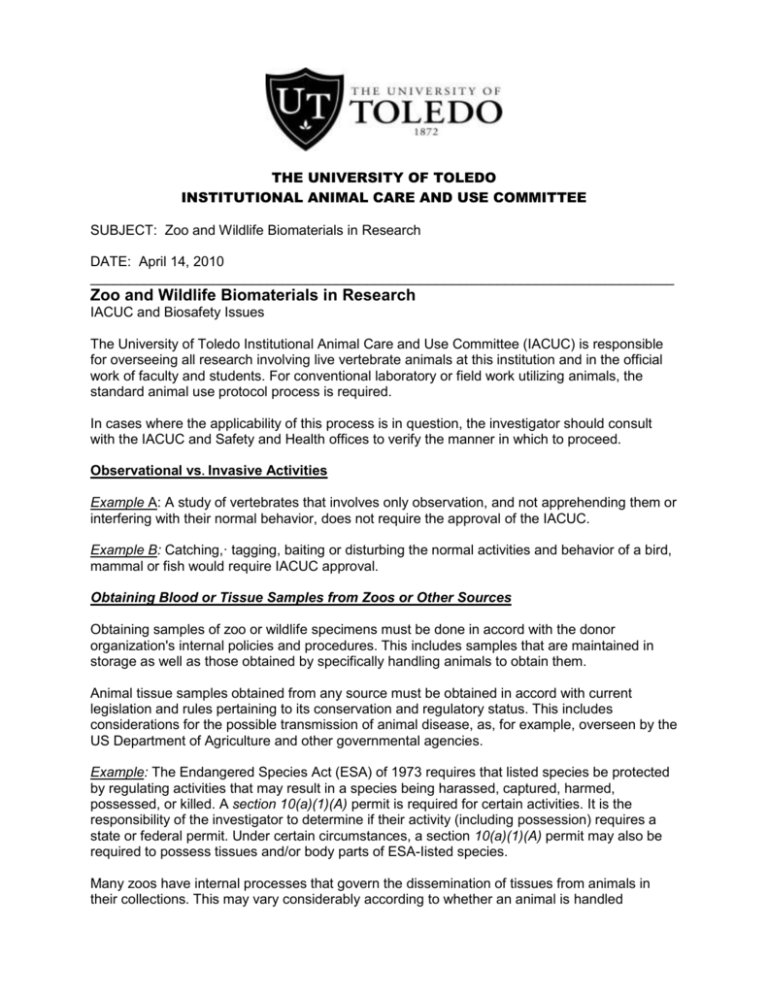
THE UNIVERSITY OF TOLEDO INSTITUTIONAL ANIMAL CARE AND USE COMMITTEE SUBJECT: Zoo and Wildlife Biomaterials in Research DATE: April 14, 2010 ____________________________________________________________________________ Zoo and Wildlife Biomaterials in Research IACUC and Biosafety Issues The University of Toledo Institutional Animal Care and Use Committee (IACUC) is responsible for overseeing all research involving live vertebrate animals at this institution and in the official work of faculty and students. For conventional laboratory or field work utilizing animals, the standard animal use protocol process is required. In cases where the applicability of this process is in question, the investigator should consult with the IACUC and Safety and Health offices to verify the manner in which to proceed. Observational vs. Invasive Activities Example A: A study of vertebrates that involves only observation, and not apprehending them or interfering with their normal behavior, does not require the approval of the IACUC. Example B: Catching,· tagging, baiting or disturbing the normal activities and behavior of a bird, mammal or fish would require IACUC approval. Obtaining Blood or Tissue Samples from Zoos or Other Sources Obtaining samples of zoo or wildlife specimens must be done in accord with the donor organization's internal policies and procedures. This includes samples that are maintained in storage as well as those obtained by specifically handling animals to obtain them. Animal tissue samples obtained from any source must be obtained in accord with current legislation and rules pertaining to its conservation and regulatory status. This includes considerations for the possible transmission of animal disease, as, for example, overseen by the US Department of Agriculture and other governmental agencies. Example: The Endangered Species Act (ESA) of 1973 requires that listed species be protected by regulating activities that may result in a species being harassed, captured, harmed, possessed, or killed. A section 10(a)(1)(A) permit is required for certain activities. It is the responsibility of the investigator to determine if their activity (including possession) requires a state or federal permit. Under certain circumstances, a section 10(a)(1)(A) permit may also be required to possess tissues and/or body parts of ESA-Iisted species. Many zoos have internal processes that govern the dissemination of tissues from animals in their collections. This may vary considerably according to whether an animal is handled specifically to procure a specimen or whether the specimen was obtained in the course of other health surveillance, treatment or postmortem activities. Example A- IACUC Protocol Not Required: When zoo personnel routinely handle animals for various health and husbandry purposes to collect diagnostic, research and health screening samples, surplus biomaterials may become available. Specimens obtained consequents to these routine activities do not require a UT-IACUC protocol. However, the UT Department of Safety and Health should be consulted to resolve any questions about biosafety precautions/procedures which are appropriate for potential human exposures to viable animal tissues. Example B- IACUC Protocol Is Required: A request is made that requires that an animal be handled, sedated or subjected to surgery specifically to accommodate the request for biomaterials.(e.g., blood sample, tissue biopsy). Such activities would require an approved protocol from the UT-IACUC, as well as concurrence with the IACUC or management of the donor institution, if applicable. Example C- IACUC Protocol Not Required: Preserved tissue samples (frozen serum, frozen or fixed tissues) are available from a zoo, institution or governmental agency. These specimens have been banked in the course of other research or regulatory activities. The investigator may proceed with obtaining such samples without the approval of the IACUC, but should consult with the UT Department of Safety and Health for guidance on biosafety issues. The investigator is responsible for assuring that all other applicable regulatory processes are complied with. If there are questions concerning any of the activities discussed in this document, contact the UT IACUC office or Dept. of Laboratory Animal Resources for assistance.


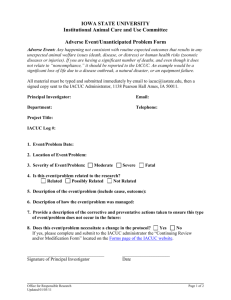
![Annual Renewal Form [Word doc]](http://s3.studylib.net/store/data/006747085_1-a9e44ad7ea0dbb852a0e727dcb34abcc-300x300.png)

